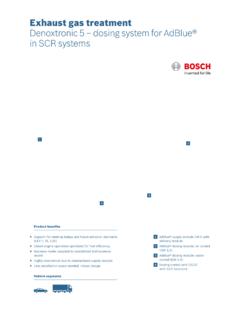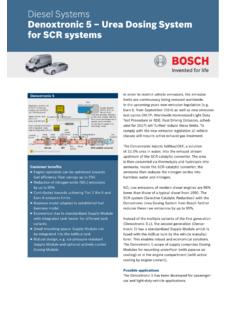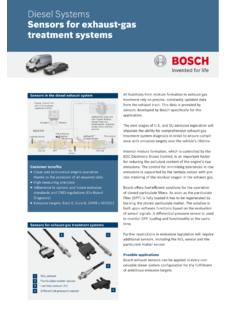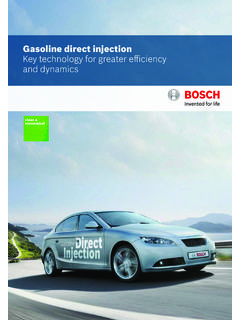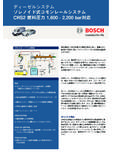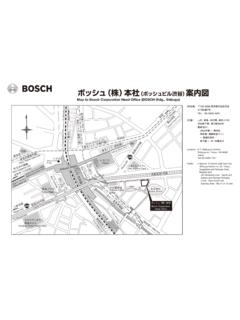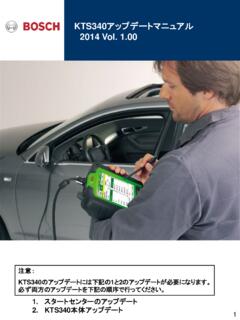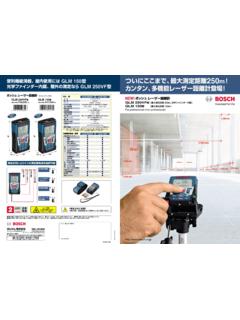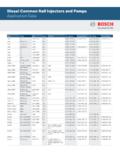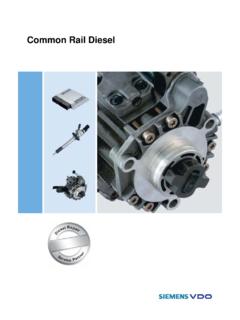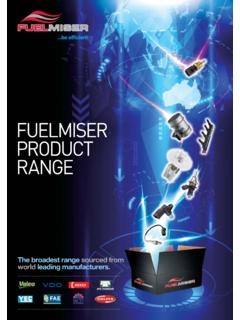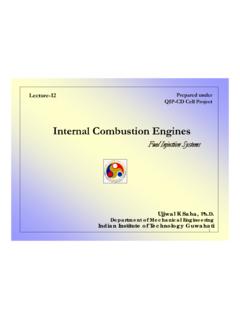Transcription of Common-rail injection systems CRS - bosch.co.jp
1 Product benefits fCost-effective and versatile due to modular design fReduced fuel consumption and emissions thanks in part to idle stop/start (ISS) and hybrid capability fCan be used in downsizing and downspeeding concepts fSuitability for Euro 6 ff. and equivalent standards fClosed-loop control of injection volume and timing fShorter injection intervals possibleVehicle segmentsCommon- rail injection systems CRS 2-25 diesel Common-rail system with solenoid valve injectors and 2,500 bar HFR-25 high-pressure railCP4-25/1 high-pressure pumpMDG1 electronic engine control unitCRI 2-25 solenoid valve injector123424138769105432111 Bosch componentsRail pressure sensorHigh-pressure railPressure control valveElectronic engine control unitSolenoid valve injectorFuel-return lineNon-return valve High-pressure pumpElectric pre-supply pumpPre-filterOther componentsFuel filterPre-supply pressureHigh pressureReturn-line pressureElectrical connectionFuel1345678910112 HRPC ommon- rail -System
2 CRS2-25 CRS 2-25 diesel Common-rail system with solenoid valve injectors and 2,500 barCRS 2-25 diesel Common-rail system with solenoid valve injectors and 2,500 barHigh-pressure pumps availableCP4 iOil-lubricated, without housingCP4 with metering unitFuel-lubricated, with housingCP4 with electric suction valveFuel-lubricated,with housingCRS 2-25 Common-rail systemThe individual components in a networked systemProduct benefits fLess weight means reduced CO emissions fExtreme pressure resistance thanks to high-tech manufacturing technologiesProduct benefits fIncreased hydraulic efficiency with electric suction valve fIdeal for idle stop/start applications without the need for additional add-on components Product benefits fExtremely short injection dwell time possible fLower fuel consumption and emissions fReduced noiseTask
3 As a key hydraulics component connecting the pump and the injectors, the high-pressure rail lends its name to the Common-rail system. It stores the fuel and supplies it to the solenoid valve The high-pressure rail communicates with the control unit via the attached rail -pressure sensor. Its measure-ment values are used by the pressure control valve to regulate system pressure. A new pressure control valve design reduces the noise that can develop. Pressure pulsations are generated in the system during the injection process.
4 The stored high-pressure volume reduces this to a minimum and thereby increases the accuracy of the injection quantity, which goes a considerable way toward reducing emissions and fuel The high-pressure pump delivers fuel at high pressure to the connected The system can be configured with different high-pressure pumps: the options are a fuel-lubricated CP4 to-gether with metering unit or electric suction valve, or else an oil-lubricated CP4 i plug-in pump. The CP4 consists of a high-pres-sure element, which is integrated into a housing with its own camshaft.
5 The belt- or chain-driven pump camshaft moves the pump plunger to generate the required high pressure. CP4 i is a plug-in pump that does not have its own housing; it is integrated directly into the engine block and is driven, for example, by the en-gine s camshaft or crankshaft. Using the optional spring-opened electric suction valve significantly improves filling of the high-pres-sure pump compared to the metering unit version, particularly in the upper speed range. This permits a reduction in inlet pressure, which enables energy demand to be reduced without affecting the required filling efficiency.
6 A further advantage of the CP4 with electric suction valve is that, for start-stop applications such as restarting after having stopped at a traffic light, it can start even with pressure stored in the rail . This saves engine components from the high stresses to which they are otherwise CRS 2-25 are built around fast-switching sole-noid valve injectors with short injection dwell times, which inject the optimum amount of fuel for the driving situation into the cylin-ders, thereby ensuring clean and economical combustion.
7 The se-cond-generation, high-performance solenoid valve injectors allow a high degree of freedom when designing the injection pattern and permit up to eight individual injections per power cycle. The-se multiple injections reduce the engine s fuel consumption as well as its CO , pollutant, and noise Thanks to its pressure-balanced solenoid valve, the CRI 2-25 injector enables system pressure to be increa-sed to 2,500 bar. The valve s fast switching times make it possible to achieve very short injection dwell times, facilitating highly flexi-ble injection patterns for multiple injections.
8 Optionally, a sensor can be integrated into the CRI 2-25, which can then measure cha-racteristic injector variables such as the closing times of the nozz-le needle. In addition, the CRI 2-20/-22/-25 injectors have an inte-grated high-pressure volume that reduces pressure pulsations and also increases hydraulic efficiency through reduced return checks a minute for optimum fuel injection controlfor high engine power combined with low fuel consumptionover 60,000up to 2,500 barindividual injections for quieter combustion plus reduced fuel consumption and emissionsup to 8to meet current and future requirements of exhaust gas legislation emissionsTask The electronic engine control unit is the heart of the engine management system.
9 It controls fuel supply, air cont-rol, fuel injection , and ignition. In addition, it is able to actuate the exhaust system, the gears, and/or vehicle functions. The electro-nic engine control unit was developed for use in diesel and gaso-line engines as well as for those using alternative fuels. Function Software inside the electronic engine cont-rol unit processes the incoming system information and controls the various functional groups; the unit networks the individual functions to form an efficient overall system.
10 To do this, it uses a new generation of high-performance microcontrollers. The soft-ware platform also guarantees maximum functional flexibility, as the previous-generation application software can be used with Autosar R4-compatible basic - 25 high-pressure pumpHFR-25 high-pressure railCRI2 -25 solenoid valve injectorElectronic engine control unitProduct benefits fEnhanced performance and scalability for current and future customer requirements fSupports safety requirements (ISO 26262) and offers new kinds of access and tuning protectionCRS 2-25 diesel Common-rail system with solenoid valve injectors and 2,500 barRobert Bosch GmbH | PO 10 60 50 | 70049 Stuttgart | Germany | in Germany 292000P1EW-2015-DS Robert Bosch GmbH 2015.
